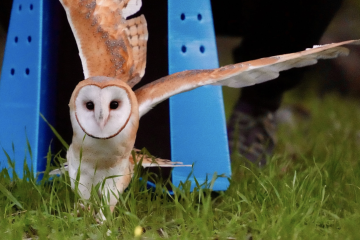Wildlife educator Dana Stangel examines how humans and coyotes can peacefully coexist—see her recorded presentation


Dana Stangel, coyote expert.
Dana Stangel, founder and executive director of Teranga Ranch Wildlife, shared her expertise and advice about how to live side by side with our most visible urban canid, the coyote. On January 29, 2025, as COSF’s first 2025 Speaker Series guest, Stangel presented “Coyotes Among Us.” Scroll down to watch the video recording of her presentation.
Stangel’s talk focused on understanding coyotes’ behavior, emphasizing that coyotes are not just passing through our Conejo Valley neighborhoods. “The reality is that the coyote was born and raised in the neighborhood. They’re not just coming down from the hills.” Why? Because, says Stangel, “Wherever there are humans there are rodents. And rodents are coyotes’ favorite food. They’re doing us a big public service by eating those rodents.”
Stangel suggested the following methods of curtailing the possibility of bad interactions with coyotes on your property, which she calls the “3 Rs”:
- Reduce resources: Contain trash in sealed containers, pick up backyard fruit, don’t leave pet food outdoors and feed wild birds by planting native gardens that produce seeds they enjoy rather than using feeders. Don’t leave small dogs or cats outside by themselves.
- Restrict entry: Stangel notes that there’s no type of yard fence that’s 100% effective against coyotes, but you can make your property less attractive with tactic #3.
- Retrain: Any time you are around coyotes, Stangel says, you are unintentionally training them, most often by reinforcing the idea that humans mean there will be food resources. So, Stangel advises, you need to convince them that humans are to be avoided. Equip your backyard with motion-triggered lighting and carry a whistle or airhorn to use to scare coyotes who wander onto your property.
Stangel also addressed the following myths:
Extermination. Killing coyotes with the goal of eliminating them from the landscape simply doesn’t work. When members of a social group are killed, a phenomenon called compensatory reproduction takes over and female coyotes in that pack will give birth to as many as 14 pups vs the normal 2 or 3.
Howling. Coyote vocalizations do not indicate a kill has taken place. Rather, coyotes yip and howl to let other coyotes know where they are in their territory. “You can rest easier knowing that’s simply communication,” Stangel says.
The Video Recording.
Resources
Teranga Ranch Wildlife. See Dana Stangel’s website for resources, private consultations and a schedule of wildlife trips.
Coyote America: A Natural and Supernatural History. A nonfiction book (or ebook) by Project Coyote ambassador Dan Flores.
California Department of Fish and Wildlife.
Poison Free Conejo Valley. For alternatives to rodenticide and to learn more about wildlife exclusion techniques.
California Wildlife Center. To report injured or sick coyotes.



0 Comments